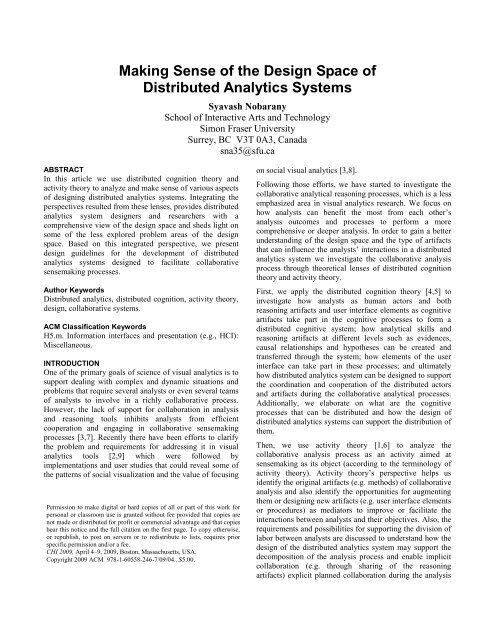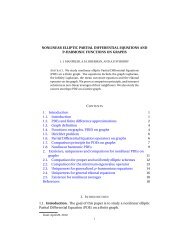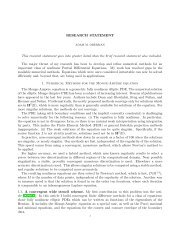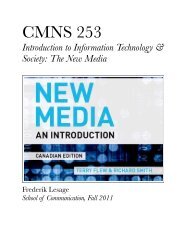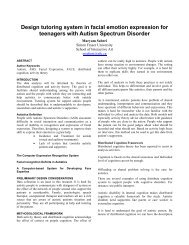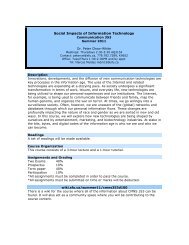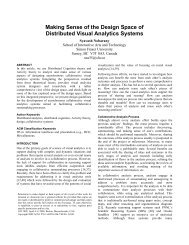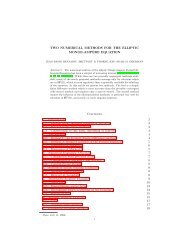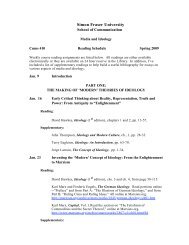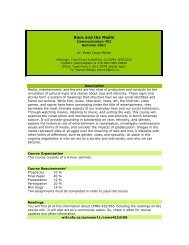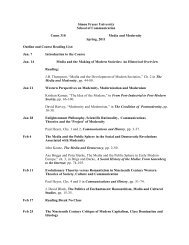SIGCHI Conference Paper Format - SFU Wiki - Simon Fraser ...
SIGCHI Conference Paper Format - SFU Wiki - Simon Fraser ...
SIGCHI Conference Paper Format - SFU Wiki - Simon Fraser ...
Create successful ePaper yourself
Turn your PDF publications into a flip-book with our unique Google optimized e-Paper software.
Making Sense of the Design Space ofDistributed Analytics SystemsSyavash NobaranySchool of Interactive Arts and Technology<strong>Simon</strong> <strong>Fraser</strong> UniversitySurrey, BC V3T 0A3, Canadasna35@sfu.caABSTRACTIn this article we use distributed cognition theory andactivity theory to analyze and make sense of various aspectsof designing distributed analytics systems. Integrating theperspectives resulted from these lenses, provides distributedanalytics system designers and researchers with acomprehensive view of the design space and sheds light onsome of the less explored problem areas of the designspace. Based on this integrated perspective, we presentdesign guidelines for the development of distributedanalytics systems designed to facilitate collaborativesensemaking processes.Author KeywordsDistributed analytics, distributed cognition, activity theory,design, collaborative systems.ACM Classification KeywordsH5.m. Information interfaces and presentation (e.g., HCI):Miscellaneous.INTRODUCTIONOne of the primary goals of science of visual analytics is tosupport dealing with complex and dynamic situations andproblems that require several analysts or even several teamsof analysts to involve in a richly collaborative process.However, the lack of support for collaboration in analysisand reasoning tools inhibits analysts from efficientcooperation and engaging in collaborative sensemakingprocesses [3,7]. Recently there have been efforts to clarifythe problem and requirements for addressing it in visualanalytics tools [2,9] which were followed byimplementations and user studies that could reveal some ofthe patterns of social visualization and the value of focusingPermission to make digital or hard copies of all or part of this work forpersonal or classroom use is granted without fee provided that copies arenot made or distributed for profit or commercial advantage and that copiesbear this notice and the full citation on the first page. To copy otherwise,or republish, to post on servers or to redistribute to lists, requires priorspecific permission and/or a fee.CHI 2009, April 4–9, 2009, Boston, Massachusetts, USA.Copyright 2009 ACM 978-1-60558-246-7/09/04...$5.00.on social visual analytics [3,8].Following those efforts, we have started to investigate thecollaborative analytical reasoning processes, which is a lessemphasized area in visual analytics research. We focus onhow analysts can benefit the most from each other’sanalysis outcomes and processes to perform a morecomprehensive or deeper analysis. In order to gain a betterunderstanding of the design space and the type of artifactsthat can influence the analysts’ interactions in a distributedanalytics system we investigate the collaborative analysisprocess through theoretical lenses of distributed cognitiontheory and activity theory.First, we apply the distributed cognition theory [4,5] toinvestigate how analysts as human actors and bothreasoning artifacts and user interface elements as cognitiveartifacts take part in the cognitive processes to form adistributed cognitive system; how analytical skills andreasoning artifacts at different levels such as evidences,causal relationships and hypotheses can be created andtransferred through the system; how elements of the userinterface can take part in these processes; and ultimatelyhow distributed analytics system can be designed to supportthe coordination and cooperation of the distributed actorsand artifacts during the collaborative analytical processes.Additionally, we elaborate on what are the cognitiveprocesses that can be distributed and how the design ofdistributed analytics systems can support the distribution ofthem.Then, we use activity theory [1,6] to analyze thecollaborative analysis process as an activity aimed atsensemaking as its object (according to the terminology ofactivity theory). Activity theory’s perspective helps usidentify the original artifacts (e.g. methods) of collaborativeanalysis and also identify the opportunities for augmentingthem or designing new artifacts (e.g. user interface elementsor procedures) as mediators to improve or facilitate theinteractions between analysts and their objectives. Also, therequirements and possibilities for supporting the division oflabor between analysts are discussed to understand how thedesign of the distributed analytics system may support thedecomposition of the analysis process and enable implicitcollaboration (e.g. through sharing of the reasoningartifacts) explicit planned collaboration during the analysis
process. Additionally, we elaborate on social relationswithin the community of analysts and the role of theserelations to better understand how the design of the systemcan support them trough facilitating the establishment ofconstructive norms.Finally, outcomes of our investigations from the twoperspectives are integrated and presented as a set of designconsiderations for distributed analytics systems that cansupport collaborative sensemaking processes.REFERENCES1. Engestrom, Y. Activity theory as a framework foranalyzing and redesigning work. Ergonomics 43, 7(2000), 960–974.2. Heer, J. and Agrawala, M. Design Considerations forCollaborative Visual Analytics. Proceedings of the 2007IEEE Symposium on Visual Analytics Science andTechnology, IEEE (2007).3. Heer, J., Viégas, F.B., and Wattenberg, M. Voyagersand voyeurs: Supporting asynchronous collaborativevisualization. Commun. ACM 52, 1 (2009), 87-97.4. Hollan, J., Hutchins, E., and Kirsh, D. Distributedcognition: toward a new foundation for human-computerinteraction research. ACM Trans. Comput.-Hum.Interact. 7, 2 (2000), 174-196.5. Hutchins, E. and Klausen, T. Distributed cognition in anairline cockpit. In Cognition and communication atwork. Cambridge University Press, 1996, 15–34.6. Kuutti, K. Activity theory as a potential framework forhuman-computer interaction research. In Context andconsciousness: Activity theory and human-computerinteraction. MIT Press, 1996, 17–44.7. Thomas, J.J. and Cook, K.A. Illuminating the Path: TheResearch and Development Agenda for Visual Analytics.National Visualization and Analytics Ctr, 2005.8. Viégas, A.B., Wattenberg, M., Van Ham, F., Kriss, J.,and Mckeon, M. Many eyes: A site for visualization atinternet scale. Proceedings of Infovis, (2007).9. Viegas, F. and Wattenberg, M. Communication-MindedVisualization: A Call to Action. IBM Systems Journal45, 4.


